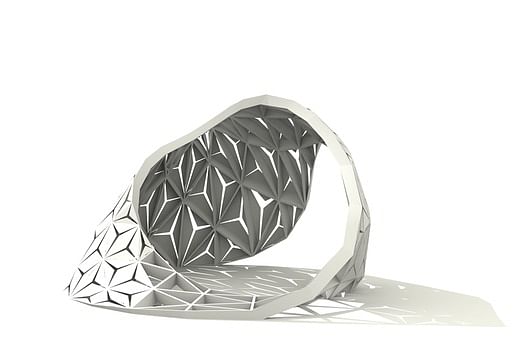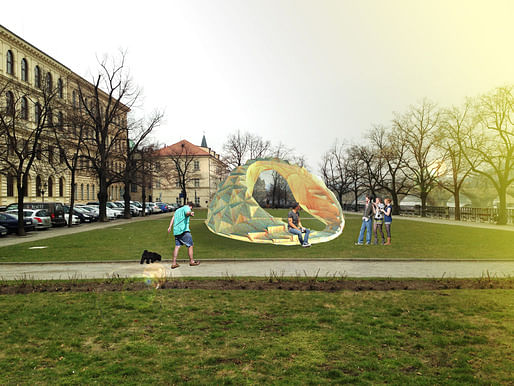
Feb '13 - Jul '13

MÖBIUS: PARESITE PAVILION
Environmental Summer Pavilion for reSITE
Led by Marie Davidová, Martin Gsandtner, Martin Šichman
Abstract:
The Paresite – The Environmental Pavilion is a mobius shaped triangular structure built from torqued pine wood planks with half centimetre thin pine wood triangular sheets that provide shadow and evaporate moisture in dry weather. The sheets, cut in the tangential section, interact with the humidity by warping themselves, allowing air circulation for the evaporation in arid conditions.
The design was accomplished in Grasshopper for Rhino in combination with Rhino and fabricated on Hundegger Speed-Cut 3 and HOMAG Venture 06S 3-axis milling machine. Few pieces had to be produced in hand as the machine doesn't accept such shallow angles.
The project was held in cooperation of the Architectural Institute in Prague (ARCHIP) and the Faculty of Forestry and Wood Sciences at the Czech University of Life Sciences Prague (FLD CZU) and the reSITE Festival. The goal was, together with the students from the mentioned schools, to design and build a pavilion from a massive pine wood that deals with its material properties and reacts to the environment.
List of the students participating on the project:
Yuliya Pozynich, Jason Nam, Alena Repina, Daria Chertkova, Yana Vaselinko, Mikkel Wennesland, Dan Merta, Daniela Kleiman, Liv Storla, David Lukas, Christopher Hansen, William Glass, Jiří Šmejkal, Milan Podlena, Josef Svoboda, Tomáš Pavelka, Miroslav Runštuk, Ladislav Rubáš, Martin Žemlička, Nefeli Dimopoulou, Dessislava Madanska, Anna Srpová, Ivana Kubicová, Gabriela Smolíková
Material Performance:
The tradition of building the wooden summer pavilions is already established at many architectural schools. The most striking examples are coming out from the AA School of Architecture in London and the Institute for Computational Design - University of Stuttgart. Usually, they are built from ply-wood. The project's aim was to experiment with the material performance of the massive wood. The strength in the torsion of the planks and the humidity – wood interaction has been explored.
The form of the pavilion doesn't allow subdivision by planar surfaces but the material's anisotropic properties support torsion. Several prototypes of the triangles with different plank thicknesses and moisture content were sampled. The angles of the cut holds the boards' torsion together in the joint. It was agreed on using green wood for the structure.
The Environmental Summer Pavilion is following the concept of wooden oriental screen-walls so called “mashrabīyas”, that absorb moisture during the night, when the relative humidity of the air is very high while evaporate and provide shadow during the arid conditions of the sunny summer days. The performance of “mashrabīyas” has been explored by Michael Hensel. Hensel writes:
“Mashrabīyas are multi-functional elements that control light penetration, airflow, privacy and views, while operating on a synergetic relation between ornamental pattern and material distribution.” (Hensel, 2011)
In the case of the Paresite, the air circulation is supported by warped triangles cut in tangential section. Warping in tangential section generates so called “cup” across the fibre. (Knight, 1961) It has been observed that most warping is ocuring on the plates in hrombus shape. Considering the material waste, this figure was replaced by two triangles. Wood – humidity interaction systems have it's origin in traditional Norwegian panelling and further on were explored by Asif Amir Khan at the AA School of Architecture with a veneer based screen. The research on performative wood is held by Michael Hensel at the Oslo School of Architecture and Design and by Steffen Reichert and Achim Menges at ICD University of Stuttgart. Most of the contemporary research has been done on laminated veneers to reach the highest performance of the material. Those structures are the best to the performance but for the pavilion that serves to a festival in public space are the systems too fragile.
The project was accomplished with the kind support of Skanska, Eurodach, Lesy České republiky and Collaborative Collective.

Blogging the process of designing and building the pavilion for the 2013 Prague ReSITE Festival. Lead by Marie Davidová with Martin Gsandtner, Martin Šichman and Lukáš Kurilla at ARCHIP and FLD - CZU. http://resite.cz http://archip.eu http://www.fld.czu.cz/en
No Comments
Block this user
Are you sure you want to block this user and hide all related comments throughout the site?
Archinect
This is your first comment on Archinect. Your comment will be visible once approved.